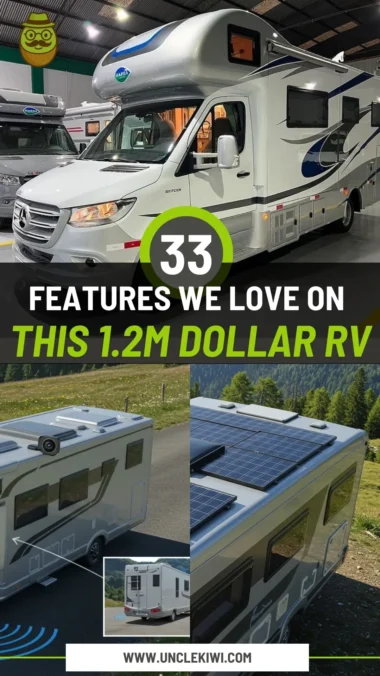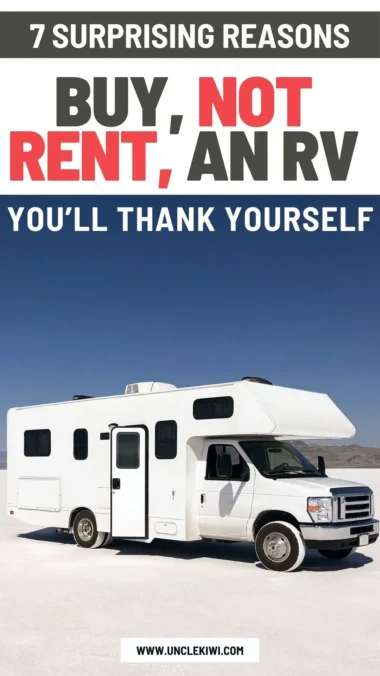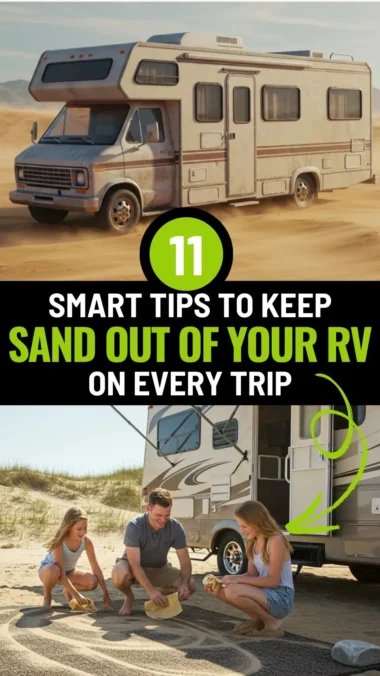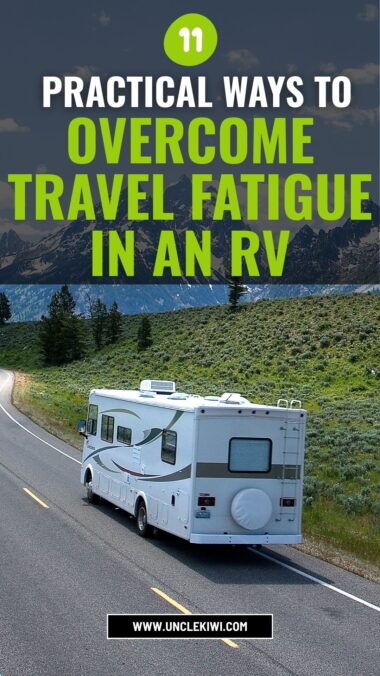7 Smart Tips for Navigating Toll Roads With an RV (Without the Stress)
Toll roads can be a time-saver when you’re road-tripping in your RV—but they can also be a source of confusion, unexpected fees, and even stress if you’re not prepared. Whether you’re a seasoned RV traveler or planning your first big journey, navigating toll roads with an RV takes a bit more planning than your average car trip.
RV tolls often depend on factors like vehicle size, number of axles, and whether you’re towing. One wrong lane or missed sign, and you could end up paying way more than you expected—or worse, facing a fine. That’s why we’ve put together this must-know list of 7 things to keep in mind when taking your RV on toll roads. From choosing the right transponder to understanding height limits, these tips will save you money, time, and unnecessary detours.

So before you hit the highway, take a few minutes to get familiar with these RV toll road essentials!
1. Know Your RV’s Classification
Toll roads often calculate charges based on the size and specs of your RV. That includes weight, number of axles, and whether you’re towing another vehicle. If you’re not classified correctly, you could be undercharged (leading to penalties) or overcharged.
Each state or toll agency may define your RV differently. For example, a motorhome with a tow dolly might be counted as a five-axle vehicle in one region and as a combo vehicle in another. There’s no universal standard, so it’s up to you to know the rules.
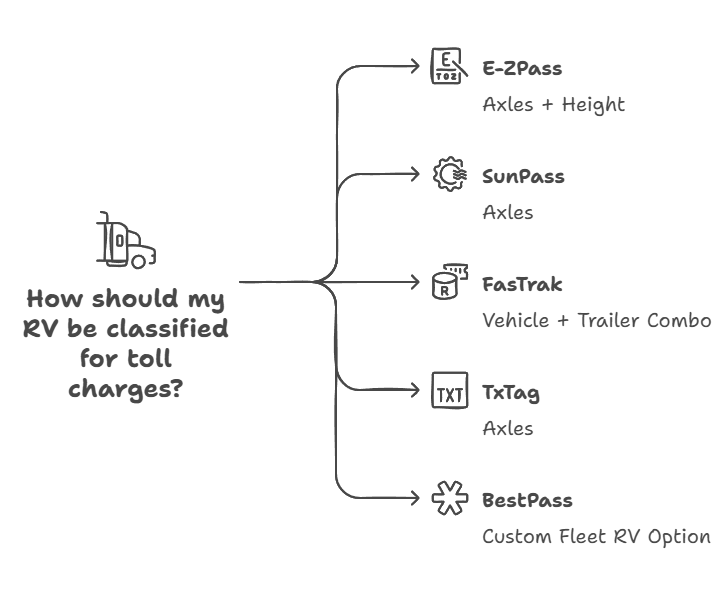
Use your vehicle manual or a weigh station to confirm your RV’s specs. Write down height, width, total length, GVWR (Gross Vehicle Weight Rating), and axle count. Keep this information handy when planning routes or setting up transponder accounts.
Common Toll Agency RV Classifications
| Toll Agency | Classification Name | Based On | Extra Notes |
|---|---|---|---|
| E-ZPass (East Coast) | Class 3/4/5 | Axles + Height | Must register trailer separately |
| SunPass (Florida) | Multi-Axle Vehicle | Axles | Towed vehicle included |
| FasTrak (California) | Vehicle + Trailer Combo | Total Axles | Charges vary by bridge/highway |
| TxTag (Texas) | Truck/RV | Axles | Higher rates for 3+ axles |
| BestPass | Custom Fleet RV Option | Custom Profile | Ideal for frequent travelers |
2. Use an RV-Friendly Toll Transponder
Most toll agencies rely on transponders to determine your toll rate. But standard car devices aren’t built for RVs. If your rig is larger or you’re towing, misreads can result in incorrect charges or missing tolls altogether.
RV-friendly transponders, like those from BestPass or PrePass, are designed to track large vehicles. These services often offer nationwide coverage and customer support tailored to commercial or oversized vehicles, including RVs.
When signing up, make sure to input your correct vehicle classification. Include details like towing status and axle count. This ensures your transponder records accurate data, and you avoid disputes or extra fees later.
3. Plan Your Route With Toll Costs in Mind
Not all toll roads are RV-friendly, and some charge high rates for larger vehicles. Before you hit the road, check your planned route for toll zones, bridge fees, and tunnel charges specific to your RV size.
Use route planning tools like RV LIFE Trip Wizard or TollGuru, which allow you to filter toll costs and RV restrictions. These tools also highlight weight or height limits, giving you safer options.
Compare your options—sometimes a toll-free scenic route is just as fast and more enjoyable. Planning ahead lets you save money and avoid sudden route changes that can be tricky in a large RV.
Toll Estimation Example by Axles
| # of Axles | Typical Vehicle | Estimated Toll (Sample Road) |
|---|---|---|
| 2 | Car or Small Van | $2–$5 |
| 3 | Motorhome (Class C) | $5–$10 |
| 4 | Motorhome + Towed Car | $10–$20 |
| 5+ | Fifth-Wheel or Class A RV with Tow | $15–$35+ |
4. Watch for Height, Weight & Width Restrictions
Toll roads often include infrastructure like tunnels and overpasses that may not accommodate large RVs. If your RV is too tall or wide, you risk serious damage—or getting stuck.
Know your exact clearance height, including roof-mounted items like solar panels, A/C units, or satellite dishes. Always measure from ground to the highest point of your setup and write it down near your dashboard.
Check DOT websites or use 511 traveler information systems to verify road restrictions. If you’re towing, also consider total combined length and weight. Violating these rules can lead to hefty fines or dangerous situations.
Related to this: 9 Unexpected RV Life Realities
5. Stick to the Correct Toll Lane
Toll plazas typically separate traffic by vehicle type. If you enter the wrong lane, it may misclassify your RV and trigger incorrect tolls or system errors. It can also cause traffic delays and stress.
Look for signs labeled “Truck/RV” or “Oversized Vehicles.” These lanes are usually wider and equipped to handle multi-axle readings or provide manual assistance. If you’re unsure, opt for a manned lane where a toll booth operator can help.
Avoid express-only lanes unless you’re sure your transponder is registered correctly for your RV setup. Using the wrong lane can result in license plate fines or lost toll records, especially on cashless systems.
6. Keep a Log of Your Toll Transactions
Toll overcharges and billing mistakes happen—especially with large vehicles or mismatched classifications. Keeping a log helps you track expenses and quickly resolve disputes.
Most toll agencies let you view detailed trip logs online. Log in regularly to verify tolls, correct errors, and download receipts. If you notice a charge that seems too high, contact the agency with your RV’s info for verification.
For cash-only toll roads, take a photo of the posted rate signs or ask for a receipt. If you’re traveling across multiple states, keep a folder or digital note with dates, toll names, and charges for easy reference.
7. Consider Avoiding Toll Roads Altogether
In many cases, toll roads are not your only option. RV-friendly routes often exist just off the main highway—and they offer more scenic and enjoyable travel experiences.
Use tools like TollGuru, RV LIFE, or even Google Maps with the “Avoid Tolls” filter to map alternate routes. These often take you through charming small towns or natural areas ideal for RV stops.
Avoiding tolls can also help reduce wear on your wallet and your nerves. You’ll skip stressful merges, tight plazas, and last-minute exits. Just double-check that your alternate route supports your RV’s size and weight.
Do RVs have to pay more on toll roads?
Yes, tolls for RVs are typically higher due to size, weight, and number of axles. Rates vary by state and toll agency.
Can I use my E-ZPass with an RV?
You can, but it’s essential to register your RV’s correct size and axle count with your E-ZPass account to ensure accurate billing.
What happens if I go through a toll road without a transponder in my RV?
Most systems will take a license plate photo and send a bill by mail. However, if your RV isn’t registered with the toll agency, you may face higher rates or penalties.
Are there toll transponders made specifically for RVs?
Yes. Services like BestPass offer transponders designed for RVs and large vehicles, with nationwide coverage.
How can I find out if a toll road has RV restrictions?
Check the state’s DOT website or use apps like RV LIFE, TollGuru, or 511 for updated restrictions and fees.
Do toll costs include trailers or towed vehicles?
Yes. Towed vehicles usually count toward your total axle count, increasing your toll fee.
What’s the best app for RV route planning with tolls in mind?
RV LIFE Trip Wizard, TollGuru, and Google Maps with toll avoidance filters are among the top tools.
Can I deduct tolls from my RV trip expenses for taxes?
Generally, tolls are only tax-deductible if you’re using the RV for business purposes. Check with a tax professional.
Is it safe to take an RV through toll tunnels?
Only if your RV meets the posted height, width, and hazardous material restrictions. Always check in advance.




